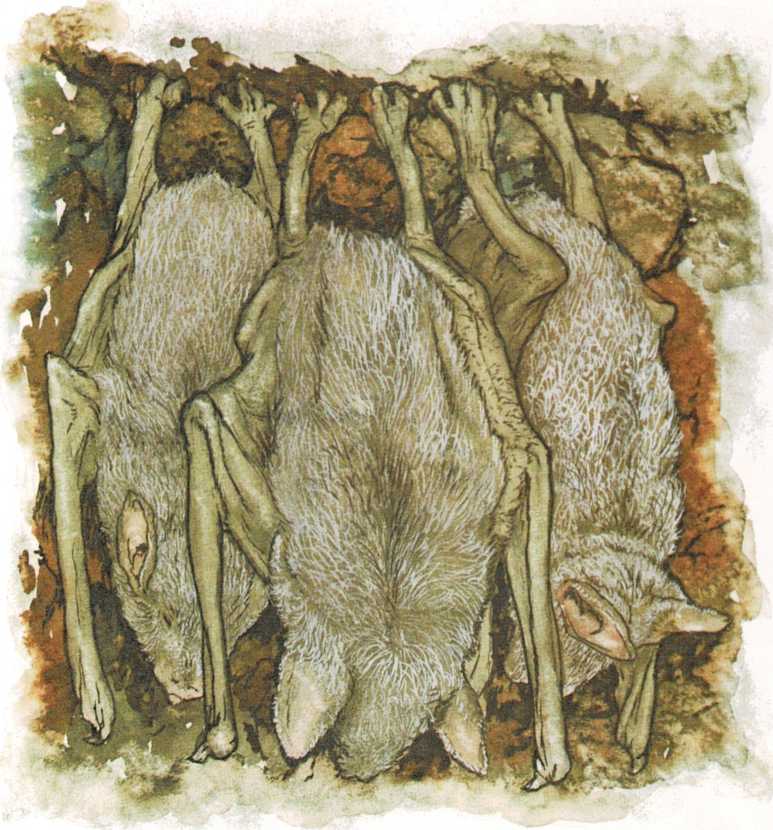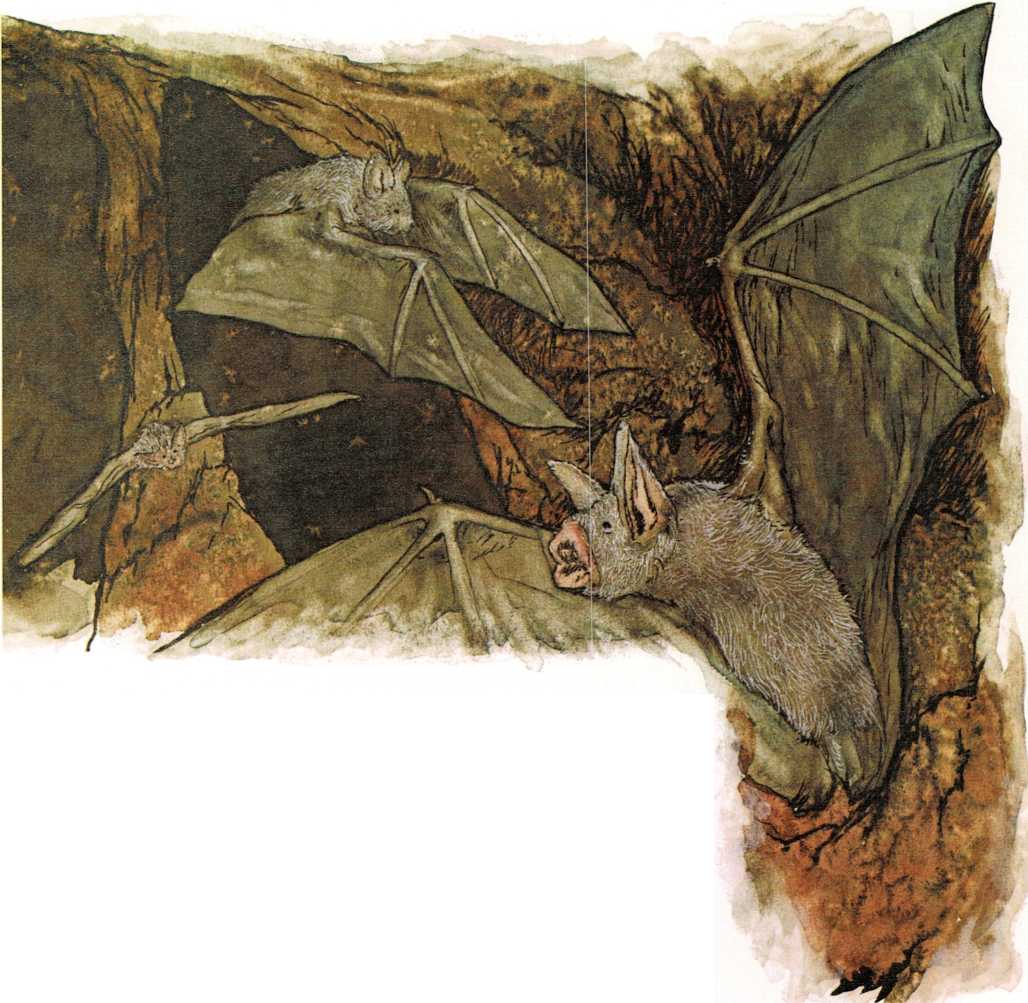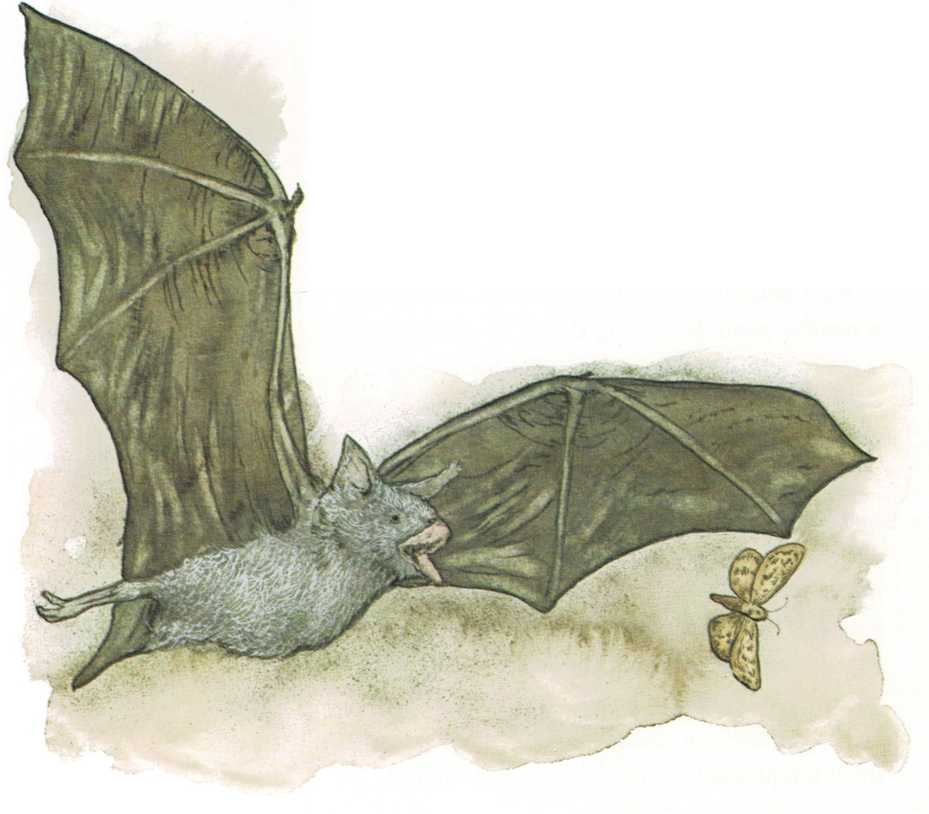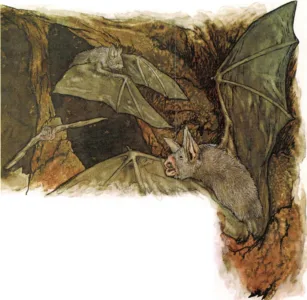
Hunter in the Darkness
In a cave in Texas, a furry, gray bat hung head downward, his eyes
closed. The curved, sharp claws on his toes clung to the rough rock of
the cave’s ceiling. Even though he slept, the bat could not fall.
Pressing against him on all sides, hanging asleep as he was, were other
bats. The walls and ceiling of the cave were a forest of furry bodies.
Even had there been light in the cave, not a bit of rock could have been
seen. It was completely covered by tens of millions of bats! They
stretched from just within the cave’s entrance to deep down inside. In
the dark depths of the cave, the entrance was only a small circle of
light, far in the distance.
Outside the cave it was late afternoon. The sky was bright and blue,
although the sun was low.
The bat’s eyes opened. He began to clean himself. He licked the smooth
skin on the inside of his wings. Then he combed the fur on his body with
the claws of one foot. After a time, he let himself drop from his perch.
As he fell, he opened his wings and flew toward the cave entrance.
As he flew, the bat held his mouth open, his lips pushed into the shape
of a horn. From his throat came a constant series of squeaking noises.
Each squeak made the air vibrate more than thirty thousand times a
second. These squeaks couldn’t have been heard by a human—they were
too high. For, people cannot hear any sound that vibrates the air more
than twenty thousand times a second.
The sound waves sped out of the bat’s open mouth. They moved through the
air in a straight line ahead of him. Whenever they

struck anything—a part of the cave, or another bat—they bounced
straight back. The bat’s big ears picked up the returning sound waves.
The vibrations made the bat’s eardrums vibrate and send a message to his
brain. And his brain told him instantly where and how far away the
object was.
The bat joined many others near the entrance of the cave. They grew more
excited
as evening approached. Squeaks and the noise of many flapping wings
filled the cave. The sound became as loud as the noise of a fast
moving railroad train!
Soon, even though the sky was still bright, millions of bats began to
stream out of the cave entrance. To anyone watching from a distance,

getting dark. This didn’t matter a bit to the
bat. From his open mouth came one burst of
it would have looked like a thick cloud of smoke pouring up out of the
cave.
With many of the others, the bat headed for a nearby pond. Swooping
down, he scooped up a mouthful of water. Then, with his thirst quenched,
he wheeled away through the sky to find food.
It was dusk by now, and the sky was quickly sound vibrations after
another. These shot out ahead of him. Each burst lasted only a fraction
of a second. After each, the bat listened for a quick moment. From
echoes that came back, he could \”see” anything ahead of him, from a
thick telephone pole to a tiny winged insect.
And, it was tiny flying insects the bat was hunting for. Any insect that
flew through the bat’s stream of vibrations, even up to eleven and a
half feet (3.5 meters) away, sent an echo bouncing back. At once, the
bat knew exactly where the insect was and in what direction it was
moving. In less than a second, he had scooped it up and eaten it!
Anyone watching the bat might have thought he was flying aimlessly. He
seemed to be darting, swooping, and wheeling in all directions.
Actually, he was catching insects as fast as they crossed his path—as
many as fifteen or twenty a minute!
The biggest and choicest insects were plump moths. The bat gladly
gobbled up those when he found them. But moths weren’t always easy to
catch. Some moths could feel the sound vibrations the bat sent out.
Then they would try to escape.

A moth that felt the bat’s vibrations would dodge and veer and zig-zag.
It might suddenly fold its wings and let itself drop straight down,
almost to the ground. At the last moment, it would swoop into some
bushes and hide. Often, the bat couldn’t catch moths that did such
\”tricks.”
Other kinds of moths had a different way of escaping. When they felt the
bat’s sound vibrations come at them, they quickly sent back vibrations
of their own. When these reached the bat’s ears, he turned aside at once
and let the moth go on its way. The bat had learned that moths that made
those sounds weren’t good to eat. Their vibrations meant, \”Don’t eat
me—I taste bad!”
Although the bat missed some moths, and let others go, he still managed
to catch plenty of insects. By the time he started back toward the cave,
he was comfortably full. All night long, he had hunted in a world of
darkness. But by using sounds, the bat \”saw” things as clearly as if
they were in bright light!
A bat’s way of using echoes to \”see” things is known as echolocation.
Actually, bats are not blind, and can see in daylight. But by being
able to hunt in darkness, they have an enormous food supply that they
don’t have to share with many other creatures.

